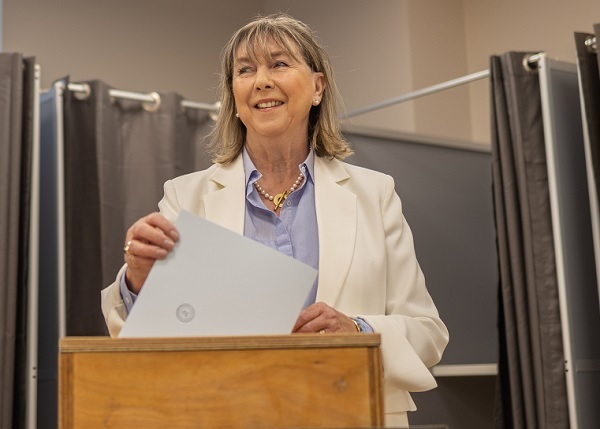 Luxembourg City Mayor, Lydie Polfer, casting her vote on Sunday;
Credit: Ali Sahib
Luxembourg City Mayor, Lydie Polfer, casting her vote on Sunday;
Credit: Ali Sahib
On Sunday 11 June 2023, Luxembourg went to the polls to elect new local / municipal councillors (Colleges of Aldermen) for a six-year term; the (unofficial) results were known shortly midnight (Sunday-Monday).
The headquarters of The Government IT Centre was where all votes were received, recorded and published. A total of 3,831 candidates (down from 3,847 originally) were running for 1,121 mandates: according to official records compiled by the Ministry of Home Affairs, there were 1,480 women (38.55%) and 2,351 men (61.45%) running for election. Of the total number of candidates, 379 were non-Luxembourg nationals.
Out of 99 constituencies (where local elections were held - a couple did not have elections as the number of candidates was not more than the number of elected positions), 56 were by proportional representation and 41 by relative majority.
The total electorate was 329,146 (281,960 Luxembourg nationals, 47,186 non-Luxembourg nationals).
Of a total of 278,361 votes cast in the ballot box, 252,858 were valid. A total of 55,821 postal votes were also cast.
In the largest constituency, the DP held their majority and won 10 seats, with the incumbent mayor, Lydie Polfer, topping the poll with 15,212 votes. The other seats were taken by the CSV (6), the Greens (5), LSAP (3) and one each for dei Lenk, ADR and the Pirate party (which picked up their first ever local council seat).
In Esch-sur-Alzette, the second-largest, the LSAP (Steve Faltz attracted 4,514 votes) and CSV (the incumbent mayor, Georges Mischo, topped the poll with 4,977 votes) parties both took 6 seats, with the DP and the Greens picking up two each, and dei Lenk, ADR and the Pirate party taking one each.
Looking at each of the main parties, the LSAP dropped from 24.01% of the vote in 2017 to 21.3% in 2023; however, they held the same number of seats (155). For the DP, they increased their share of votes from 18.16% to 20.64%, and now have 134 seats compared to 108 seats in 2017. For the Greens, they dropped their share of votes from 16.35% to 12.69%, with their number of seats falling from 77 to 64. And the CSV party also saw a drop in vote percentages, from 30.44% in 2017 to 26.06% in 2023, with their number of seats falling from 209 to 193.
The CSV may still be the largest party in local elections; however, their percentage of votes has dropped and so has their percentage of seats (38% to 35%). What this means for the national elections in October shall be interesting to follow. The LSAP has stayed steady at 28%, with the DP rising from 19% to 24% and the Greens dropping from 14% to 11%.








